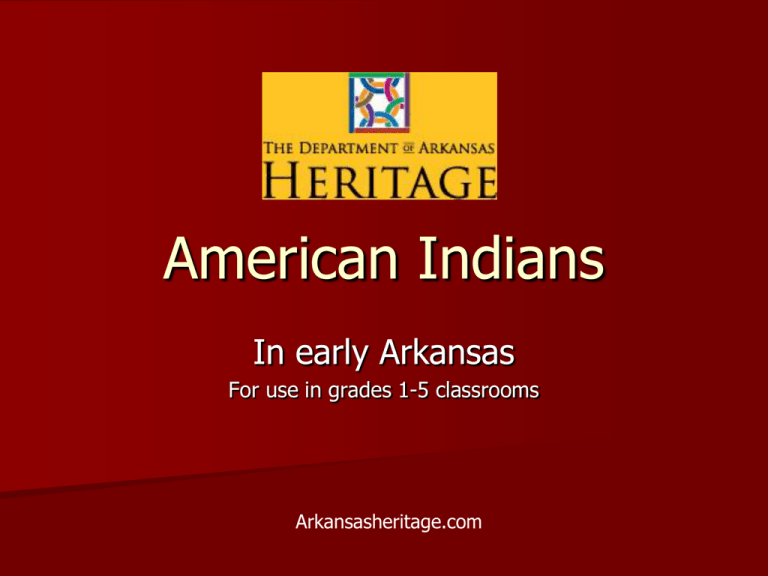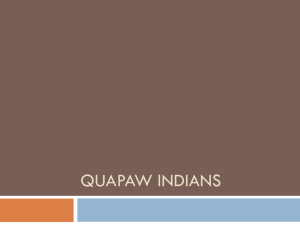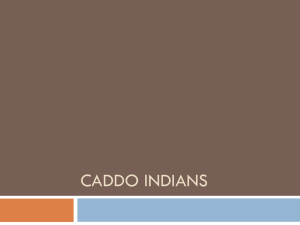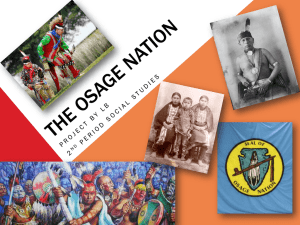Arkansas-Native-Americans
advertisement

American Indians In early Arkansas For use in grades 1-5 classrooms Arkansasheritage.com Arkansas frameworks related to American Indians in Arkansas The following frameworks are addressed in the following Power Point, grades K-5 – H.6.K.9: Understand the name of Arkansas originated from the Quapaw Indians – H.6.2.11: Recognize American Indian tribes of Arkansas: Osage, Quapaw and Caddo – H.6.3.14: Identify and describe the Arkansas Indian tribes: Osage, Quapaw, and Caddo – H.6.4.15: Identify the reasons for the decline of the native populations of Arkansas (e.g. influenza, small pox, competition for land) – H.6.5.29: Locate and describe the three main Indian cultures in Arkansas during the exploration period: Quapaw, Caddo and Osage Indians Who are American Indians? American Indians were the first people to live in the Americas. They were here before the Europeans came and settled in the area we call the United States. This map shows you where American Indians live today There were three main American Indian tribes in early Arkansas Caddo Osage Quapaw Let’s find out about the Caddo Nation! The original name of the Caddo was Cadohadacho When the Europeans came to North America, the Caddo lived in the present states of Louisiana, Arkansas, Oklahoma, and Texas. Today, most of the Caddo live in the state of Oklahoma. The Caddo looked like this Osage Nation The Osage Indians also lived in Arkansas – They originally lived in present day Oklahoma, Missouri, Kansas and Arkansas. – Today, most of the people of the Osage Nation live in Oklahoma. The Quapaw Tribe The name Quapaw (Ugakhpa or O-gahpah) is translated as “people who live downstream.” Our state is named for this American Indian tribe! The Quapaw looked like this Other early American Indians in Arkansas: Tunica-Biloxi Tribe and Chickasaw Nation The Tunica-Biloxi Tribe mainly lived in Mississippi, Louisiana and Arkansas. Today the Tunica-Biloxi people are referred to as the Tunica-Biloxi Tribe of Louisiana and live in Louisiana. The people of the Chickasaw Nation lived in the northeast corner of the state. The Chickasaw primarily lived in the states of Mississippi, Alabama, Tennessee, Kentucky and Missouri. Today most of the Chickasaw live in the state of Oklahoma. Culture of the Caddo, Osage and Quapaw Culture is how a people live. It includes such things as the following: their language, clothing, hair styles, transportation, food, homes, how children are raised, music, arts, and folklore. Let’s look at the culture of the these three tribes : the Caddo, Osage and Quapaw. First, the Caddo! Language Most Caddo speak English today but many also speak the Caddo language. Example: “Kua’at”(pronounced Kooah-aht) is a friendly greeting. Caddo men’s clothing Caddo men wore breechcloths and sometimes leather leggings. Caddo women Caddo women wore wraparound skirts and poncho tops made of deerskin. They usually braided their hair or tied it back with ribbons. Both men and women wore earrings and moccasins. Hair styles! Men wore their hair in a scalplock. (One long lock of hair on top of their head usually braided). Sometimes the men wore a “ roach” or headpiece made of red-dyed deer hair and turkey beards. “turkey roach” Women and hair styles Caddo women usually wore their long hair in a bun. For special occasions they would add ornaments or ribbons to their bun. Caddo transportation The Caddo preferred to travel by land but also made dugout canoes out of logs for travel by water. What kind of food did the Caddo eat? The Caddo Indians were farmers and hunters. – They grew corn, beans, pumpkins and sunflowers. – They hunted deer, buffalo and small game and fished. Tools used by the Caddo To hunt they used bows and arrows They also made axes with a heavy stone head to chop wood. When they fought other people, they used their bows and arrows and their tomahawk. Caddo ax Caddo homes Caddo homes were tall, dome-shaped grass houses. Sometimes they were so large, 30 people could live in them! How were Caddo children raised? Caddo children were busy doing chores for the family. They did not have much play time. – They did play with dolls and toys. A game they played was trying to throw a dart through a moving hoop. (hoop dart anyone?) Caddo art The Caddo people were famous for their pottery. Caddo music The favorite Caddo musical instrument is the drum. As drums are played, other Caddo dance and sing. Caddo Indian legends and folklore One story is called, “Village Boy and Wild Boy.” It is about mythical twins whose mother was killed by a monster. Another story is called “Coyote.” It is about a tricky figure who gets involved in different forms of mischief! Next is the Osage! What was their language? As with the Caddo Indians, the Osage speak English today, but there is a renewed interest in learning the Osage language which is part of the Dhegihan language group. Osage clothing Osage women wore trade cloth dresses and leggings. Both men and women wore moccasins and long buffalo hide robes in cold weather. As with the Caddo, they wore tattoos. Osage women wore clothes similar to this. Osage men Osage men wore breechcloths and leggings just like the Caddo men did. Hairstyles and headdresses Osage men either wore their hair long or in a scalplock fashion. If they had a scalp lock they would sometimes wear a “roach.” Osage Women Osage women wore their hair braided or tied back with ribbons. Osage transportation The Osage used dogs to carry heavy loads when they traveled. It would look something like this! Osage food The Osage were big game hunters. They liked to hunt buffalo. Before they had horses, the men would drive the buffalo off a cliff to kill them. Osage women raised corn, beans, squash and pumpkins. Osage tools and weapons The Osage used bows and arrows and were known for their excellent long bows. In battles they also fought with clubs and spears! Osage homes The Osage lived in settled villages and their homes were called lodges. Lodges were made of elm bark. Music of the Osage As with the Caddo, the Osage played drums and a flute-like instrument. Osage folklore A popular story among the Osage is “The Spider and the People.” This story is about how the spider became the symbol for the Osage. And now, the Quapaw! The Quapaw language Like the Caddo and Osage Indians, the Quapaw speak English but many also speak their Quapaw language. What did the Quapaw men wear? Similarly to other Native Americans, the men wore breechcloths with leather leggings and buckskin shirts. Men and women both wore moccasins and long buffalo robes in cold weather. In warm weather, the Quapaw wore less clothing, just like us! Quapaw women Quapaw women wore long deerskin dresses and wore their hair loose or braided. Quapaw men’s hairstyles and head coverings! Quapaw men often adorned their heads with a scalplock and wore a “roach” like Caddo and Osage men. Quapaw Leaders sometimes wore a headdress. Tribal tattoos Native Americans had special tattoos depending on their tribe and their deeds. These tattoos had religious significance. tattoos Transportation The Quapaw knew how to make dugout canoes from cypress trees, but they usually traveled by land. They used dogs to pull a travois (like a sled) when they traveled by land. (The Osage did this also.) What did the Quapaw eat? The Quapaw ate basically the same things as the Caddo and Osage. The were farmers and ate corn, beans and squash. The men provided meat through the hunting of small game and organized buffalo hunts. Tools and weapons The Quapaw used bows and arrows to hunt and to fight. They also used war clubs and spears. War clubs could take many different forms. Quapaw homes Quapaw homes took time to build. They were made of river cane, wood and vines and coated with plaster. The roof was usually made of grass or tree bark. Quapaw children Quapaw children did the same thing that Caddo and Osage children did. They did chores and sometimes got to play with dolls or play games. As with other Native Americans, Quapaw mothers carried a young child in a cradleboard on her back. Image is courtesy of the Wisconsin Historical Society, www.wisconishistory.org Art by the Quapaw This is Quapaw artwork. Here is an example of Quapaw beadwork. Music and the Quapaw Like the Caddo and Osage, the Quapaw enjoyed music and dancing. Quapaw stories and legends Storytelling was very important to the Quapaw. One of their stories is about a monster or ogre. What were the roles of men and women among these three Indian tribes? Primarily the women were farmers, childcare givers and cooks. The men were the hunters and sometimes warriors if necessary. Chiefs were usually men. Both men and women participated in artwork, music, storytelling and medicine. What type of government did they have? Most Indian tribes/nations elected chiefs based on their character, family descent and ability. – Chiefs were usually men but could be women. A tribal council actually governed the tribe or nation. Where are the American Indians of Arkansas today? There are no federally recognized Indian tribes in Arkansas today. What are the reasons? – Disease American Indians did not have immunities from European introduced diseases such as influenza, small pox, measles, mumps, etc. Fifty to eighty percent of American Indians died in the first century of European contact. Decline of American Indian population, continued Warfare – Battles between American Indian tribes caused a decline – The introduction of firearms (guns) made battle more deadly Decline of population (3) Enslavement – Some American Indians were kidnapped and forced to be slaves in rich agricultural lands to the east Decline of population (4) Desire for Indian land – After the purchase of the Louisiana territory by the U.S. government in 1803, many European settlers moved to the area. Treaties were signed that essentially took the land away from the American Indians. The land was a rich agricultural region desired by the new immigrants to the area Let’s do a Review! First the Caddo American Indians American Indian tribe Language Clothing Caddo Originally they Men wore spoke the Caddo breechcloths and language. leather leggings. Today they speak English and many of them also speak the Caddo language. Women wore skirts and tops made of animal skins. Both wore moccasins and earrings. Hair & hair styles Men wore their hair long or in a style called a scalplock They sometimes wore a “ roach”. Women wore long hair in a bun. American Indian Tribe Caddo Food Transportation The Caddo liked to travel by land, but also made dugout canoes for travel by water. They grew and ate corn, beans, pumpkins, and sunflowers. Also, they hunted deer, buffalo, small game and fished. Native Tribe Tools and weapons Caddo Bows and arrows were They were tall, used to hunt. Axes dome-shaped were used to chop grass houses. wood. In battle they used bows and arrows and tomahawks. Homes American Indian tribe Caddo Children They helped with chores. When they had time they played with dolls and toys and played games! Art The Caddo were famous for their very nice pottery. American Indian tribe Music Legends and folklore Caddo The Caddo loved the drum. They also loved to dance and sing. The Caddo had legends and stories they passed down through their children. Time to review the Osage! American Indian tribe Language Osage The Osage Clothing Osage men spoke their own wore language, but breechcloths now speak and leggings. English. Many speak their Women wore native language deerskin also. dresses and leggings. Both wore moccasins and tattoos. Hair styles Men wore their hair long or wore a scalplock. Sometimes they added a “roach.” Women wore their long hair loose or braided. American Transportation Food Indian Tribe The Osage Osage people Osage preferred to travel by land. They would use dog sleds to carry heavy loads when they traveled. This is called a travois. liked to hunt big game such as buffalo. The women raised corn, beans, squash and pumpkins. American Tools and Indian weapons tribe The Osage used Osage bows and arrows and longbows. They also used clubs and spears in battle. Homes Osage homes were called a lodge. They were made of elm bark. American Children Indian Tribe Osage children Osage performed chores and had some time to play. When they played, they used dolls, toys and games. Art Pottery and beadwork were crafts at which the Osage excelled. American Indian Tribe Osage Music Folklore and legends They played the drums and a flutelike instrument. Both men and women told stories to pass on information to the children. One special story was about how the spider became the symbol for the Osage. And now, it’s the ???? Quapaw! American Language Indian Tribe Quapaw Like other native tribes, the Quapaw had their own language. Clothing The men wore breechcloths with leggings and buckskin shirts. Women wore long deerskin Today they dresses. speak English and many speak Both wore their native moccasins and language also tattoos. Hair and hair styles Quapaw men shaved their heads except for a scalplock. They also wore a roach. Women wore their long hair loose or braided. American Transportation Indian tribe Quapaw Food The Quapaw made They ate corn, and traveled by beans and dugout canoes. squash. They also used dogs to pull a travois or sled when traveling with heavy loads by land. The men hunted small game and buffalo. American Tools and weapons Indian Tribe Homes Quapaw Their homes were permanent and took time to build. They were made of wood, vine, river cane and had a roof of grass or tree bark. The Quapaw people used bows and arrows and clubs and spears. American Children Indian tribe Quapaw Quapaw children, like other children, helped with the family chores and sometimes got to play with toys or play games. Art The Quapaw were very good at making pottery and doing beadwork. American Music Indian Tribe Legends and folktales Quapaw Storytelling was important to the Quapaw as it was with the Caddo and Osage. One of their stories was about a monster! The Quapaw also liked to play musical instruments and to dance! Review: Why did American Indian population decline in Arkansas? Which are the correct answers? -attacks by savage animals -disease -storms -floods -desire for their land by European settlers -warfare -earthquakes -enslavement That ends the Power Point on American Indians of Arkansas Caddo Osage Quapaw The information information in in this this power power point point was was made made possible possible through through The the many many great great sources sources on on the the internet internet and and in in books books available. available. the There are are many many internet internet sites sites and and books books on on the the Native Native There Americans of of Arkansas Arkansas available available from from those those who who have have worked worked Americans hard to to preserve preserve Native Native American American history. history. Each Each tribe tribe has has its its own own hard website to to preserve preserve its its history history and and its its culture.. culture.. AA list list of of internet internet website sites follows follows on on the the next next two two slides. slides. II would would like like to to thank thank Dr. Dr. sites Trey Berry, Berry, author author of of The The Arkansas Arkansas Journey Journey,, for for his his advice advice and and Trey guidance and and the the many many people people who who have have preserved preserved information information guidance on the the rich rich heritage heritage of of American American Indians. Indians. on This power point was produced by Michele Wasson, Education Coordinator, Department of Arkansas Heritage. Matt Reed, Curator of American Indian Collections, Oklahoma Historical Society, edited and approved this Power Point for use in the elementary classroom. Internet sources used http://www.google.com/images?q=Osage+women&rls=com.micros oft:en-us:IE-SearchBox&oe=&um=1&ie=UTF8&source=og&sa=N&hl=en&tab=wi&biw=1259&bih=823 http://www.osagetribe.com/ http://www.loc.gov/teachers/classroommaterials/themes/nativeamericans/ http://www.bigorrin.org/osage_kids.htm http://www.bigorrin.org/caddo_kids.htm http://www.bigorrin.org/chickasaw_kids.htm http://www.google.com/images?hl=en&biw=1276&bih=809&gbv=2 &tbs=isch%3A1&sa=1&q=Tunica+indians&btnG=Search&aq=f&aqi =g1&aql=&oq=&gs_rfai= http://www.southshore.com//louisianapurchase.htm Sources, continued http://www.arkansasarcheology.org http://www.google.com/images?hl=en&source=imghp&biw=1276&bih=809 &q=quapaw+indians&gbv=2&aq=f&aqi=g2&aql=&oq=&gs_rfai= http://www.google.com/images?hl=en&biw=1276&bih=809&gbv=2&tbs=is ch%3A1&sa=1&q=Caddo+Indians&aq=f&aqi=g10&aql=&oq=&gs_rfai= http://www.chickasaw.net/index http://www.google.com/images?hl=en&biw=1276&bih=809&gbv=2&tbs=is ch%3A1&sa=1&q=Tunica+indians&btnG=Search&aq=f&aqi=g1&aql=&oq= &gs_rfai= http://www.native-languages.org/arkansas.htm http://www.osagetribe.com/ http://www.native-languages.org/osage.htm http://nmai.si.edu/subpage.cfm?subpage=visitor http://www.ehow.com/about_4569448_quapaw-indian-tribe.html http://www.accessgenealogy.com/native/tribes/quapaw/quapawhist.htm http://www.bigorrin.org/quapaw_kids.htm http://wisconsinhistory.org











